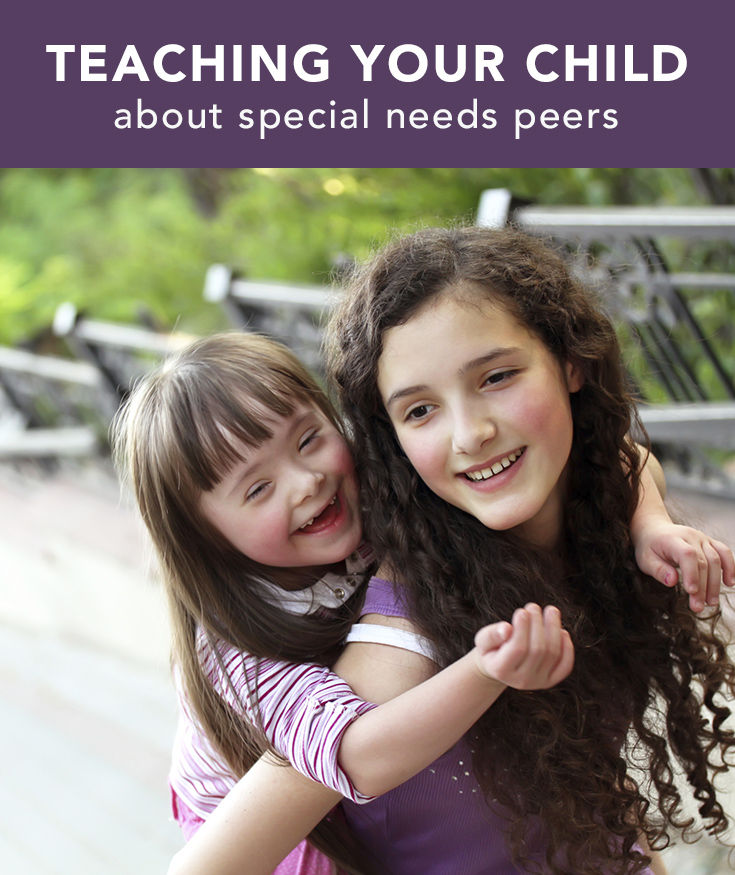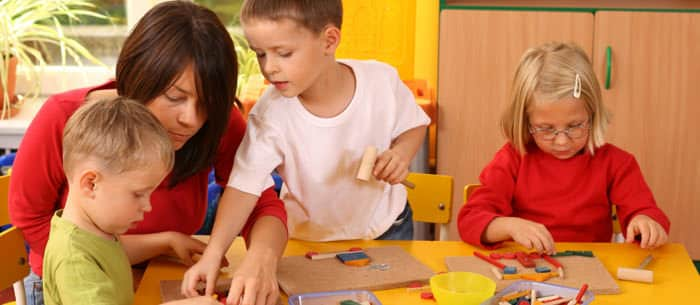According to her mother, 8-year-old J. is “really sweet and loves attention.” She goes to her friend’s house, does horseback riding, and likes to play board games. She also has cerebral palsy, and is non-verbal and non-ambulatory. She uses augmentative communication boards to communicate and a wheelchair for mobility. At her public school, J. has a one-on-one aide and spends time both in and out of her third grade classroom.
Disabilities cover a wide range. Some are obvious — such as a child with a physical disability who uses a wheelchair or a child with a visual impairment who uses a cane to navigate when walking. Other disabilities may be more “hidden” — for example, children who have learning disabilities or autism spectrum disorder.
Basic ideas to share with your child
Chances are that at some point your child will have a classmate with a disability. Just as you guided your very young child when he or she began to befriend others, you can encourage your child to learn about and be a friend to children who have disabilities.
- No two people are the same — some differences are just more noticeable.
- A disability is only one characteristic of a person. People have many facets: likes and dislikes, strengths and challenges.
- Children with disabilities are like all children in that they want friends, respect and to be included.
- Children can be born disabled or become disabled from an accident or illness. You can’t “catch” a disability from someone else.
- Just because someone has a physical disability (when a part or parts of the body do not work well) does not mean they necessarily have a cognitive (or thinking) disability.
- Children with disabilities can do many of the things your child does, but it might take them longer. They may need assistance or adaptive equipment to help them.
Try to use clear, respectful language when talking about someone with disabilities. For a younger child, keep explanations simple, such as, “She uses a wheelchair because a part of her body does not work as well as it could.”
Reinforce with your child that name calling — even if meant as a joke — is always unacceptable as it hurts people’s feelings.
Special needs at school
While each child learns differently and at his or her own pace, children with disabilities may need extra school support or accommodations. Many children with special needs attend public schools; others may go to private or other schools. If your child has a classmate with special needs, he or she may notice certain things.
- Special teachers may come into the classroom to work one-on-one with the student.
- Sometimes students will leave the room for a part of the day for individualized attention.
- Accommodations may be present in the classroom. For example, a teacher may wear a microphone so that a student with a hearing impairment can hear better in school.
Getting to know children with disabilities
Paradoxically, when it comes to approaching someone with a disability, children may be better at it than their parents because they are less inhibited. Some adults — especially those without previous exposure to people with disabilities — may be more timid. Worried about appearing intrusive or insensitive, they may not know what to say or do.
“The other kids are great,” J.’s mom says, “They are very direct, which is good. They like her and want to interact with her.”
However, if your child (or you, for that matter) is unsure about approaching a child with a disability, here are some helpful tips:
- Most parents of children with disabilities would prefer that other adults ask them about their child directly, rather than avoiding them. A smile or friendly “Hello!” is an easy icebreaker.
- Even if a child doesn’t talk, there are still activities the children can do together, such as play board games or arts and crafts.
- If your child wants to have a play date with a child with a disability or invite him or her to a birthday party, encourage it. Call the other parent and say simply, “How can we make this work?”
- Share any concerns with the other parent. Parents of children with disabilities will often be happy to facilitate a successful play date or outing.
- Extra effort goes a long way. For instance, learning simple signs so that you can better communicate with a child who is deaf (and uses sign language) will be much appreciated.
Learning more about disabilities
Reading or learning about a disability is a great way to further understand a child’s experiences. It may also help dispel any questions you or your child may have.
Your local library and librarian can be a great resource for finding age-appropriate books and materials.
- Read picture books with younger children and discuss them afterward.
- Chapter books with characters who have special needs are appropriate for older readers. Ask your child about the book when he or she is done — maybe you’ll be intrigued and read it yourself.
- Some audio-visual materials have positive portrayals of children with disabilities. “Sesame Street,” for example, routinely includes children with disabilities in their episodes.
- Websites with age-appropriate explanations and activities can be interesting and fun to explore.
Disability-awareness programs in schools
Find out if your child’s school offers any disability-awareness curriculum. These types of programs teach children about different disabilities, often through engaging activities and guest speakers. Consider volunteering if they need parent volunteers — it can be a wonderful experience for both you and the students.
Helpful Links
- Kids’ Quest, National Center on Birth Defects and Developmental Disabilities
- University of Wisconsin at Oshkosh bibliography on children’s books about disabilities
- Indiana Institute on Disability and Community, Indiana University, Bloomington, Kids’ Corner






